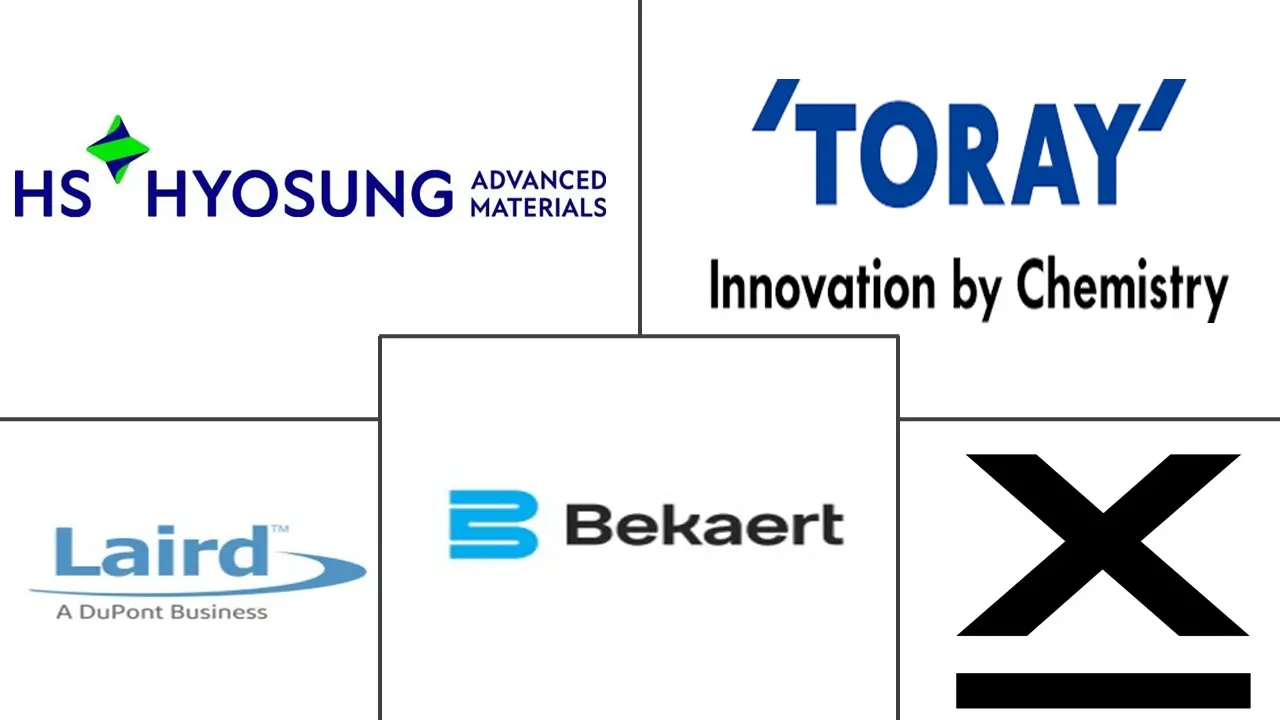Conductive Textiles Market Size and Share
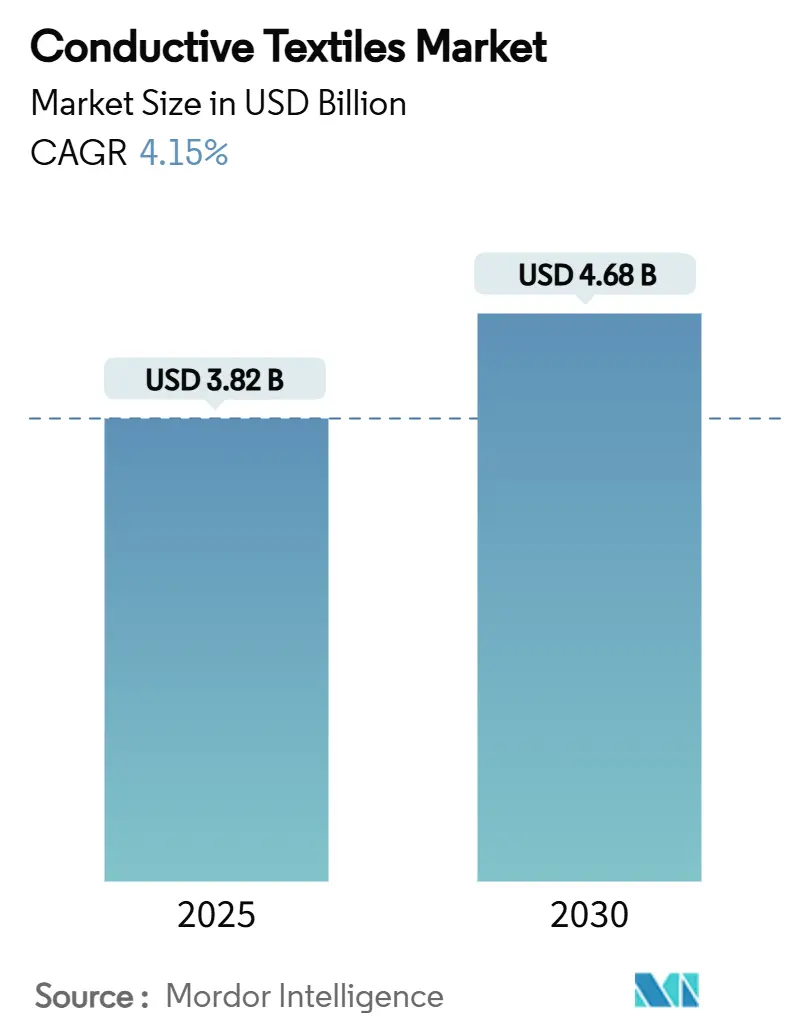
Conductive Textiles Market Analysis by Mordor Intelligence
The Conductive Textiles Market size is estimated at USD 3.82 billion in 2025, and is expected to reach USD 4.68 billion by 2030, at a CAGR of 4.15% during the forecast period (2025-2030). Sustained demand for lightweight electromagnetic-interference (EMI) shielding in autonomous vehicles, growing military modernization programs, and the rapid spread of healthcare wearables are the principal forces enlarging the conductive textiles market. Rising integration of artificial‐intelligence algorithms with textile-based sensors is turning garments into real-time health-monitoring platforms, while carbon-based yarns answer sustainability mandates without sacrificing conductivity. Automotive OEMs embed woven shielding fabrics behind dashboards and seat covers to protect advanced driver-assistance systems, and gaming brands use tactile haptic panels to enrich e-sports apparel. As these trends converge, the conductive textiles market is moving from niche prototypes toward large-volume consumer and industrial supply chains.
Key Report Takeaways
- By fabric type, nylon led with 42.61% revenue share in 2024, while its 5.05% CAGR keeps it the fastest-advancing fabric through 2030.
- By conductive material, metal-coated fibers held the top 35.18% share in 2024; carbon-based textiles record the highest 5.32% CAGR over the outlook period.
- By technology, woven constructions commanded 47.41% of 2024 value and are projected to climb at a 4.98% CAGR to 2030.
- By end-user industry, defense and military applications accounted for 30.33% of 2024 revenue, whereas other emerging industries expand at 5.21% CAGR to 2030.
- By application, antistatic and EMI shielding captured 44.18% share in 2024; sensing solutions lead growth at a 5.14% CAGR through 2030.
Global Conductive Textiles Market Trends and Insights
Drivers Impact Analysis
| Driver | (~) % Impact on CAGR Forecast | Geographic Relevance | Impact Timeline |
|---|---|---|---|
| Increasing Adoption in Smart Fabrics and Wearable Electronics | +1.2% | Global, with concentration in North America and Asia-Pacific | Medium term (2-4 years) |
| Growing Demand from Defense and Military Intelligent Gear | +0.8% | North America and Europe, expanding to APAC | Long term (≥ 4 years) |
| Expansion of Physiological-Monitoring Healthcare Wearables | +1.0% | Global, led by developed markets | Short term (≤ 2 years) |
| Rising Need for EMI Shielding in Autonomous-Vehicle Interiors | +0.7% | APAC core, spill-over to North America and Europe | Medium term (2-4 years) |
| Growth of Haptic-Feedback E-Sports Apparel | +0.4% | Global, concentrated in urban centers | Short term (≤ 2 years) |
| Source: Mordor Intelligence | |||
Increasing Adoption in Smart Fabrics and Wearable Electronics
Miniaturized chips now slip inside yarns, turning shirts, socks, and hospital gowns into connected devices that read motion, temperature, and heart rates without rigid modules. Hospital groups are procuring washable monitoring garments to cut skin-adhesive discomfort and to free nurses from wired sensors, accelerating commercial orders. Integrated energy-harvesting layers remove bulky batteries, extending wear time and widening consumer acceptance. Athletic brands market performance outfits that stream biometric data to mobile dashboards, and insurers explore policy discounts tied to verified activity logs. The spread of these real-time insights cements conductive fabrics as a core building block of next-generation digital health ecosystems.
Growing Demand from Defense and Military Intelligent Gear
Armed forces seek lighter uniforms that combine power distribution, radio links, and adaptive camouflage in one fabric panel[1]European Defence Agency, “Textile Integration for Soldier Systems,” eda.europa.eu. Woven conductive grids replace cables, cutting soldier carry weight and reducing snag hazards in confined vehicles. U.S. naval research funds low-cost signature-management cloth that can heat, cool, and sense chemical threats in the field. Field trials indicate 20% faster mission setup times because electronics arrive pre-wired in garments, lowering the fumbling of connectors under stress. With long procurement cycles, approved suppliers secure multi-year contracts that anchor demand even when commercial markets fluctuate.
Expansion of Physiological-Monitoring Healthcare Wearables
Textile electrodes match the accuracy of gel pads yet avoid skin irritation, enabling multi-week cardiology studies outside hospitals. Clinics remotely track chronic conditions, cutting readmissions and freeing beds for acute cases. For seniors, smart vests signal fall risk or respiratory decline, allowing earlier interventions that reduce emergency costs. Algorithmic analysis of continuous data feeds also supports precision dosing in cardiac and diabetes care. Payers studying pilot programs report improved adherence and lower long-term expenditure, bolstering reimbursement arguments that drive wider roll-outs.
Rising Need for EMI Shielding in Autonomous-Vehicle Interiors
Electric powertrains and radar arrays pump out electromagnetic noise that can scramble safety sensors unless cabins are lined with shielding cloth. Silver-plated woven fabrics block more than 77 dB while adding negligible weight versus metal foils. Tier-1 suppliers stitch these panels behind headliners and under carpets to satisfy evolving compatibility mandates. With production of autonomous shuttles ramping in Asia-Pacific, fabric makers secure multi-year volume contracts. Regulators tightening millimeter-wave limits ensure shielding demand remains structural rather than cyclical.
Restraints Impact Analysis
| Restraint | (~) % Impact on CAGR Forecast | Geographic Relevance | Impact Timeline |
|---|---|---|---|
| High Production Cost and Price Premium | -0.9% | Global, particularly affecting emerging markets | Medium term (2-4 years) |
| Durability and Wash-Wash Cycle Degradation | -0.6% | Global, with higher impact in consumer applications | Short term (≤ 2 years) |
| Absence of Global Testing and Quality Standards | -0.4% | Global, with regional variations in regulatory approaches | Long term (≥ 4 years) |
| Source: Mordor Intelligence | |||
High Production Cost and Price Premium
Conductive yarns demand vacuum sputtering or polymer metallization steps that add process minutes and material waste, lifting unit prices by up to 40% versus conventional fabrics. Low volumes hinder scale economies, especially for niche medical patches. Buyers in price-sensitive mass fashion stall adoption until cost curves bend. Equipment amortization further squeezes smaller mills, limiting geographic spread and reinforcing supply concentration in capital-rich regions. Although learning rates are improving, the premium remains a brake on rapid commoditization.
Durability and Wash-Wash Cycle Degradation
Laundering scours coatings and bends microfilaments, raising resistance and dulling sensor accuracy after 40 wash cycles. Protective over-coats improve life but add stiffness and cost. Without universal durability labels, consumers hesitate to pay more for garments that may fail mid-season. Industrial buyers, such as hospitals, also require predictable sterilization outcomes, making repeatability a gating factor in procurement tenders. Progress in plasma treatments and encapsulated yarns is promising yet not fully proven at industrial scale.
Segment Analysis
By Fabric Type: Nylon Leads Performance Applications
Nylon represented 42.61% of 2024 sales and is projected to grow at a 5.05% CAGR through 2030, underscoring its versatility across rugged defense gear and form-fitting sportswear. Its tensile strength withstands battlefield abrasion, while its chemical resilience accepts silver, copper, or carbon coatings without significant fiber degradation. The conductive textiles market benefits as automakers specify nylon mesh for headliner shielding, pushing mill demand upward.
Elastic recovery keeps sensors seated against skin during motion, sustaining signal quality for medical garments. Cotton retains share in comfort-first hospital linens, but nylon captures new contracts where durability and stretch matter most. On the research front, silver-coated nylon achieved conductivity of 96 S/cm in washability trials and still met breathability targets, expanding its runway in premium functional apparel.
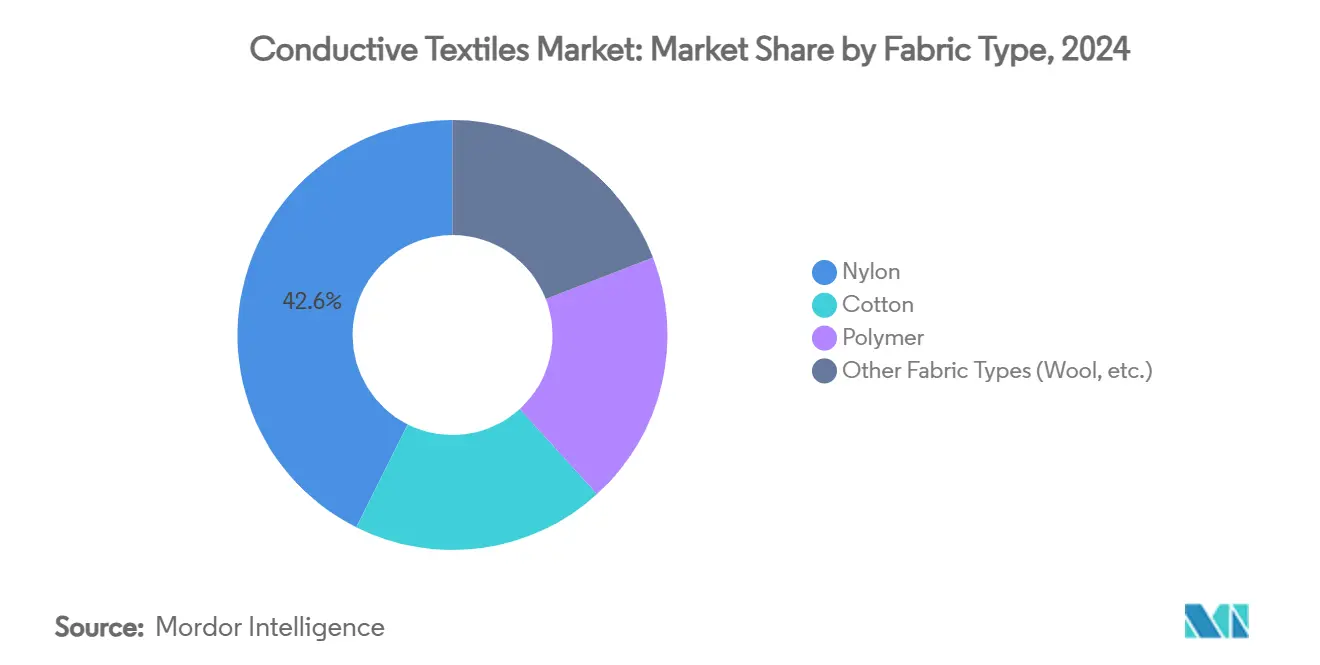
Note: Segment shares of all individual segments available upon report purchase
By Conductive Material: Metal-Coated Fibers Dominate Despite Carbon Growth
Metal-coated fibers owned 35.18% of 2024 revenue thanks to proven EMI shielding in aerospace and automotive assemblies. Their low sheet resistance meets stringent aircraft avionics protocols. However, carbon-based textiles post the briskest 5.32% CAGR to 2030 as regulators steer away from heavy metals. Graphene weaves provide robust elasticity and maintain conductivity despite repeated bending, suiting consumer electronics sleeves. Cost curves for carbon nanotube inks are falling, narrowing the historical price gap. Hybrid yarns that combine carbon cores with thin metallic skins are emerging to balance conductivity with sustainability goals.
By Technology: Woven Fabrics Excel in Structural Applications
Woven constructions captured 47.41% of 2024 demand and are headed for a 4.98% CAGR through 2030, reflecting their structural integrity and uniform electrical pathways. Three-dimensional weave patterns embed complex circuits, allowing localized heating or sensing without extra layers. Knitted fabrics target stretchable sports gear, though higher resistance limits their role in rigorous EMI shielding. Non-wovens stay relevant in disposable sterile covers where low cost trumps performance. Automation in jacquard looms now places conductive yarn only where needed, trimming waste and reducing finished-goods cost.
By End-User Industry: Defense Leads While Consumer Applications Accelerate
Defense accounted for 30.33% of 2024 revenue, reflecting long-term modernization projects and the preference for battlefield-proven materials. Yet consumer electronics and automotive sectors propel the fastest 5.21% CAGR as wearable controllers and in-cabin sensors scale production. Hospital networks broaden use of smart bedding to detect patient movement, moving healthcare past pilot stages. Sportswear brands adopt conductive panels for muscle-activation feedback, elevating training apparel beyond mere moisture management. Diversified demand reduces revenue cyclicality tied to military budgets.
By Application: EMI Shielding Dominates Current Demand
Antistatic and EMI shielding represented 44.18% of 2024 turnover, driven by dense electronics in cars, aircraft, and 5G base stations. Conductive cloth shields cockpit avionics without adding metal weight. Sensing applications, forecast to advance at 5.14% CAGR, capture investment as Internet-of-Things roll-outs require flexible form factors. Heating panels maintain relevance in outdoor gear and battery-temperature management. Energy harvesting remains nascent but benefits from research that raises triboelectric power densities to device-ready levels.
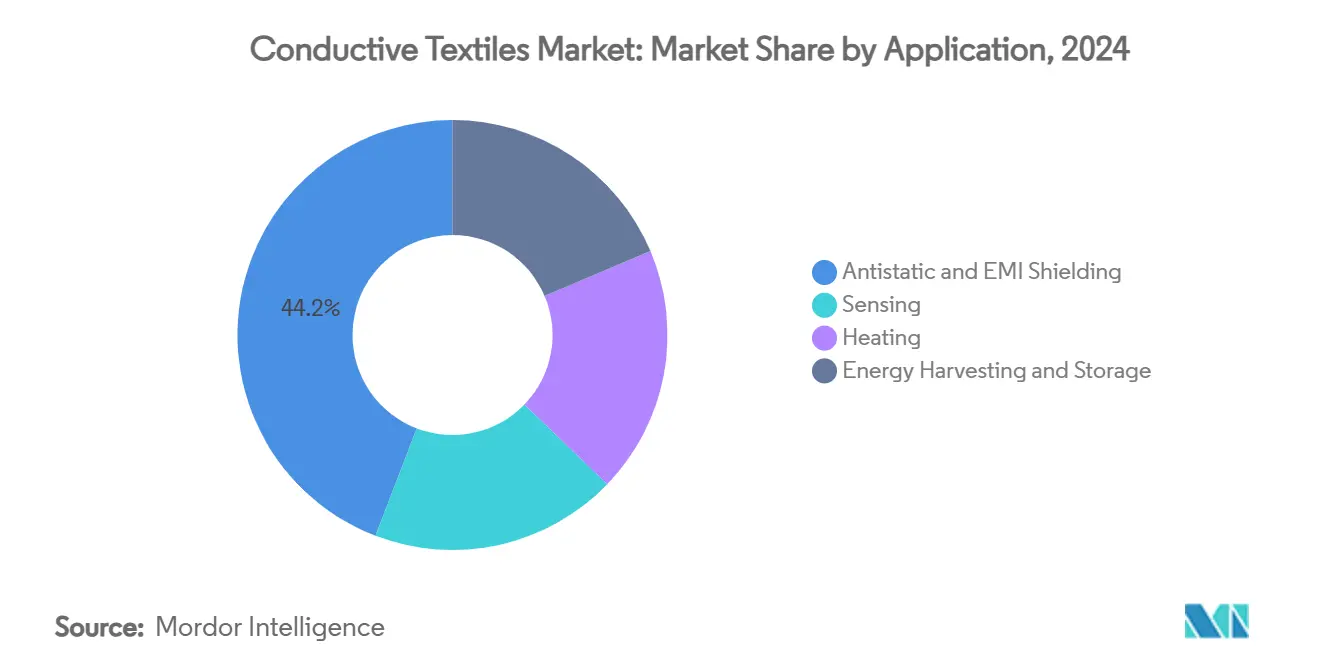
Note: Segment shares of all individual segments available upon report purchase
Geography Analysis
North America held 41.02% of 2024 revenue, powered by defense procurement contracts and early adoption of connected healthcare garments. Advanced supply links between textile mills and chip designers shorten prototype cycles, allowing rapid market entry. Research institutes secure federal grants to refine wash-resilient coatings, keeping regional know-how ahead of global peers. State incentives for semiconductor reshoring further tighten local value chains, insulating lead times from geopolitical freight disruptions.
Asia-Pacific delivers the highest 4.88% CAGR to 2030 as China leverages its textile scale to undercut global prices while climbing the technology ladder. Japanese automakers embed shielding cloth in electric sedans slated for global export, locking in baseline demand. South Korean display makers invest in fabric-integrated touch sensors, broadening market avenues beyond clothing. Government subsidies for Industry 4.0 equipment help local mills retrofit lines for conductive yarns, accelerating volume and squeezing unit costs.
Europe balances solid market share with a sustainability lens that favors recyclable and metal-free alternatives. German tier-1 suppliers qualify carbon-based cloth for next-generation vehicle interiors to meet end-of-life recycling rules. Nordic brands trial bio-based conductive threads in performance outerwear, aligning with circular-economy targets. The EU’s medical-device regulation offers a clear pathway for textile electrodes, easing cross-border hospital adoption.
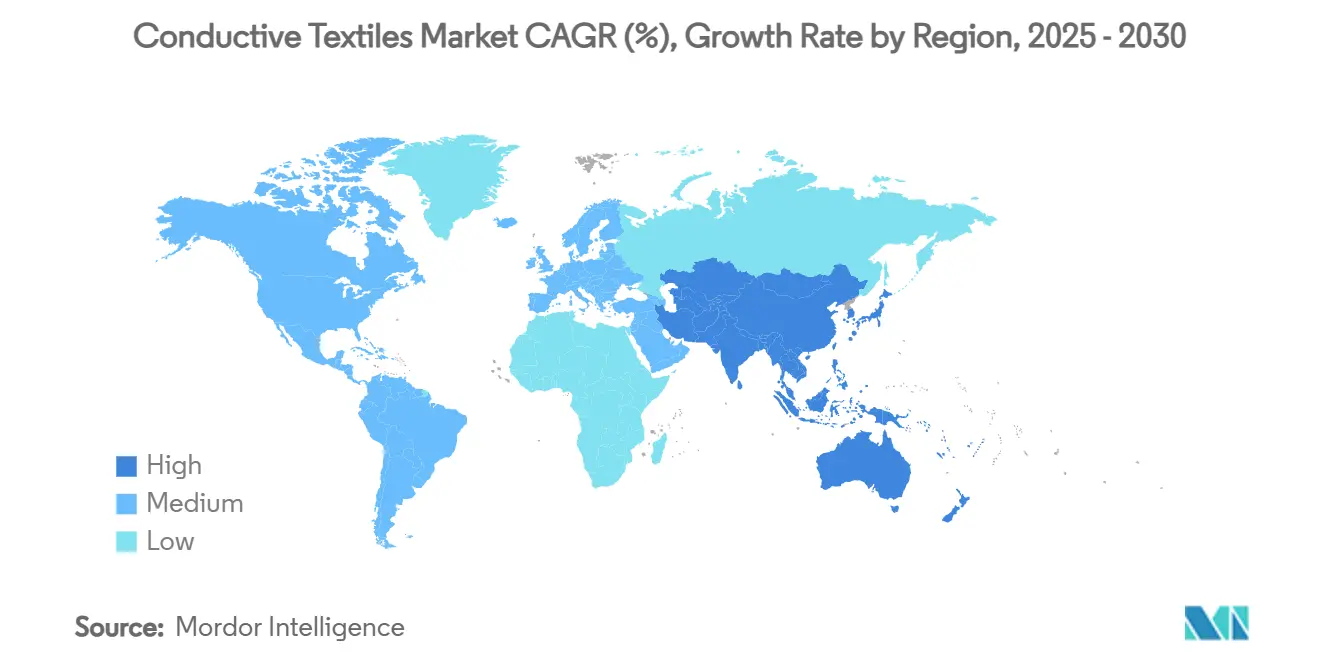
Competitive Landscape
The conductive textiles market features moderate fragmentation. Specialist firms leveraging proprietary coating chemistries compete with legacy mills now integrating electronics. Early movers secure supply agreements in defense and healthcare, locking in volumes that finance process refinements. Partnerships between yarn producers and printed-circuit makers blend textile and electronics know-how, shortening design iterations.
Competitive advantage hinges on maintaining conductivity after 50 wash cycles while keeping costs within consumer thresholds. Companies refining plasma-bonded silver coatings report resistance losses below 5% after standard home laundering, outperforming rivals by a clear margin[2]A. Singh, “Plasma-Bonded Silver Coatings for Wearable Electronics,” MDPI Coatings, mdpi.com. Standard IPC-8921 benchmarks gain traction in RFQ documents, rewarding suppliers with certified test data.
Strategic acquisitions intensify. Traditional apparel conglomerates purchase sensor startups to capture margin from smart-garment lines, while automotive suppliers buy weaving specialists to internalize EMI shielding capability. These moves tighten control over patented processes and help spread R&D expense across larger order books.
Conductive Textiles Industry Leaders
-
TORAY INDUSTRIES
-
Bekaert
-
Shieldex
-
Laird Performance Materials
-
HS HYOSUNG ADVANCED MATERIALS
- *Disclaimer: Major Players sorted in no particular order
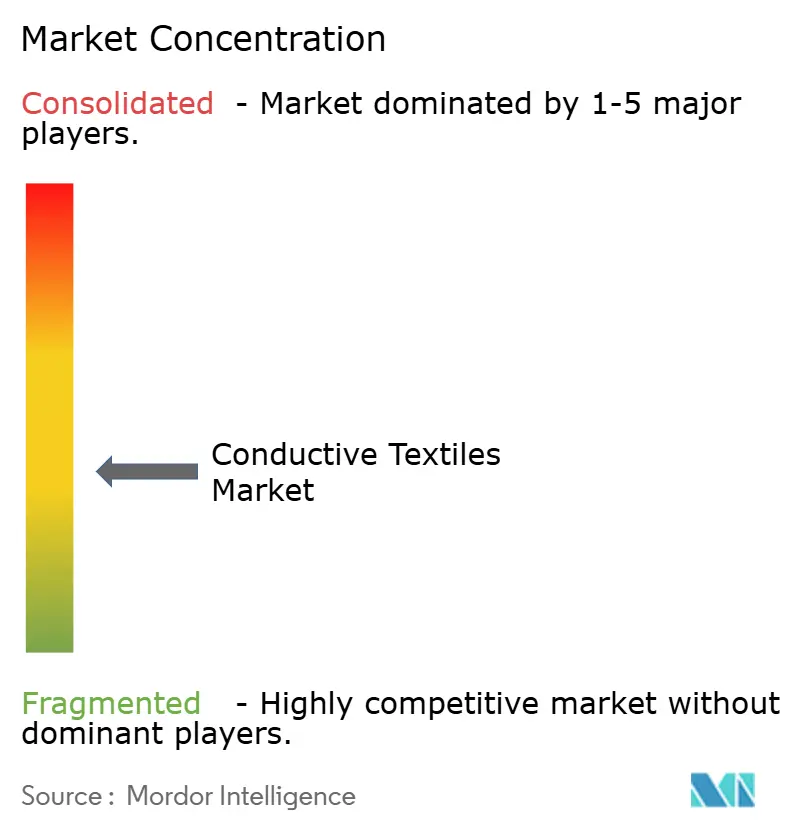


Recent Industry Developments
- December 2024: Bally Ribbon Mills developed E-WEBBINGS® e-textile products for aerospace applications that integrate embedded electronics for smart textile systems. These conductive textiles transmit data, sensations (light, noise, vibrations, heat), and power. They reduces product size and weight while improving user comfort and lowering material costs.
- August 2022: GrapheneUP launched two graphene-based products for the textile industry: INKGUP® Fabric and PRINTGUP®. These conductive textiles offer high electrical conductivity along with antibacterial and antiviral properties.
Global Conductive Textiles Market Report Scope
The Conductive Textiles Market report include:
| Cotton |
| Nylon |
| Polymer |
| Other Fabric Types (Wool, etc.) |
| Metal-coated Fibers |
| Conductive Polymers |
| Carbon-based Textiles |
| Hybrid Composites |
| Woven |
| Non-woven |
| Knitted |
| Defense and Military |
| Healthcare |
| Sports and Fitness |
| Other End-user Industries (Consumer Electronics, etc.) |
| Sensing |
| Heating |
| Antistatic and EMI Shielding |
| Energy Harvesting and Storage |
| Asia-Pacific | China |
| Japan | |
| India | |
| South Korea | |
| ASEAN Countries | |
| Rest of Asia-Pacific | |
| North America | United States |
| Canada | |
| Mexico | |
| Europe | Germany |
| United Kingdom | |
| France | |
| Italy | |
| Spain | |
| Russia | |
| NORDIC Countries | |
| Rest of Europe | |
| South America | Brazil |
| Argentina | |
| Rest of South America | |
| Middle-East and Africa | Saudi Arabia |
| South Africa | |
| Rest of Middle-East and Africa |
| By Fabric Type | Cotton | |
| Nylon | ||
| Polymer | ||
| Other Fabric Types (Wool, etc.) | ||
| By Conductive Material | Metal-coated Fibers | |
| Conductive Polymers | ||
| Carbon-based Textiles | ||
| Hybrid Composites | ||
| By Technology | Woven | |
| Non-woven | ||
| Knitted | ||
| By End-user Industry | Defense and Military | |
| Healthcare | ||
| Sports and Fitness | ||
| Other End-user Industries (Consumer Electronics, etc.) | ||
| By Application | Sensing | |
| Heating | ||
| Antistatic and EMI Shielding | ||
| Energy Harvesting and Storage | ||
| By Geography | Asia-Pacific | China |
| Japan | ||
| India | ||
| South Korea | ||
| ASEAN Countries | ||
| Rest of Asia-Pacific | ||
| North America | United States | |
| Canada | ||
| Mexico | ||
| Europe | Germany | |
| United Kingdom | ||
| France | ||
| Italy | ||
| Spain | ||
| Russia | ||
| NORDIC Countries | ||
| Rest of Europe | ||
| South America | Brazil | |
| Argentina | ||
| Rest of South America | ||
| Middle-East and Africa | Saudi Arabia | |
| South Africa | ||
| Rest of Middle-East and Africa | ||


Key Questions Answered in the Report
What is the current size of the conductive textiles market?
The conductive textiles market is valued at USD 3.82 billion in 2025 and is projected to reach USD 4.68 billion by 2030.
How fast is the conductive textiles market growing?
The market is expected to expand at a 4.15% CAGR between 2025 and 2030.
Which region holds the largest share of the conductive textiles market?
North America leads with 41.02% of 2024 revenue due to robust defense spending and early healthcare adoption.
What are the main growth drivers for conductive textiles?
Rising demand for EMI shielding in electric and autonomous vehicles, expansion of healthcare wearables, and military modernization programs are the primary growth drivers.
Which material type is gaining the most traction?
Carbon-based textiles record the fastest 5.32% CAGR through 2030, favored for durability and sustainability advantages.
Page last updated on:
